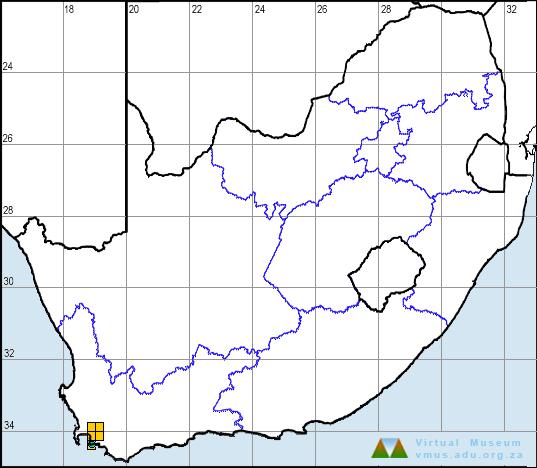View the above photo record (by Faansie Peacock) in FrogMAP here.
Find the Landroskop Moss Frog in the FBIS database (Freshwater Biodiversity Information System) here.
Family Pyxicephalidae
LANDROSKOP MOSS FROG – Arthroleptella landdrosia
Dawood and Channing, 2000
Identification
Males reach 15 mm in length (Channing 2001). This species may be identified by its advertisement call that consists of a relatively long series of strident clicks, unlike the very short, chirping call of the sympatric A. villiersi (Dawood and Channing 2000; A. Turner and A.L. de Villiers pers. comm.).
Habitat
A. landdrosia inhabits montane fynbos and forest (A.L. de Villiers pers. comm.) along streams and in seepages, including those on steep slopes. It occurs in winter rainfall areas that receive annual rainfall >750 mm.
Behaviour
Breeding takes place between September and February (spring and late summer). Males call from concealed positions in moss and beneath dense vegetation near water along streams. Nothing further is known about the life history and ecology of this species.
Status and Conservation
A. landdrosia is known from Hottentots Holland and Kogelberg nature reserves (Channing 2001; Harrison et al. 2001). Although the limited area of occupancy and extent of occurrence of this species seem to warrant a higher category of threat, major declines are not anticipated because the species occurs in generally rugged and inaccessible terrain, and the known populations are not severely fragmented. The species was therefore classified Near Threatened (Harrison et al. 2001; this publication). While the species is not considered to be under immediate threat, appropriate conservation management practices are required in order to ensure its survival in the long term.
Threats
Present and potential future threats to this species include changes in the quality of its habitat due to drainage, damming and habitat fragmentation caused by invasive alien vegetation, afforestation and frequent fires (Harrison et al. 2001).
Recommended conservation actions
More fieldwork is needed to better understand the distribution, life history and ecology of A. landdrosia. Habitat and limiting factor management, as well as regular population monitoring, are recommended (Harrison et al. 2001).
Distribution
A. landdrosia is endemic to the Hottentots Holland and Kogelberg mountains, reaching the coast near Rooi Els and Betty’s Bay (3418BD). It is found from sea level to 1600 m. The atlas distribution data are reliable.

Further Resources
Virtual Museum (FrogMAP > Search VM > By Scientific or Common Name)
More common names: Landdroskop Chirping Frog (Alternative English Name); Landdroskop-mospaddatjie (Afrikaans)
Recommended citation format for this species text:
Channing A, Tippett RM. Landdroskop Moss Frog Arthroleptella landdrosia. BDI, Cape Town.
Available online at http://thebdi.org/2022/02/12/landroskop-moss-frog-arthroleptella-landdrosia/
Recommended citation format:
This species text has been updated and expanded from the text in the
2004 frog atlas. The reference to the text and the book are as follows:
Channing A 2004 Arthroleptella landdrosia Landroskop Moss Frog. In Minter LR
et al 2004.
Minter LR, Burger M, Harrison JA, Braack HH, Bishop PJ, Kloepfer D (eds)
2004. Atlas and Red Data Book of the Frogs of South Africa, Lesotho and
Swaziland. Smithsonian Institution, Washington, and Avian Demography
Unit, Cape Town.

